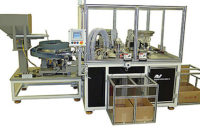Terry R. Dunbar, product manager for positioning systems at EFD Inc. (Providence, RI), shows a visitor a tiny ferrule for optical fiber. A customer wants to dispense a precise amount of expensive epoxy inside the ferrule, which is less than 3 millimeters wide and 20 millimeters long.
"This is a perfect application for a benchtop Cartesian robot," asserts Dunbar. Presented with a fixture full of ferrules, a person with a handheld dispenser would be unable to consistently locate each opening and apply just the right amount of adhesive. In contrast, a robot can do the job time after time-without ever taking a coffee break or calling in sick.
Whether it's to dispense epoxy into ferrules or gasketing material onto covers for gas meters, a growing number of assemblers are discovering the benefits of using benchtop Cartesian and SCARA robots. At an automotive assembly plant, a benchtop robot lubricates the mechanism that controls interior ventilation. An assembler of electrical products uses a robot to apply a bead of adhesive around the diaphragm for a safety switch. A footwear manufacturer uses a robot to put rubber cement onto the heels of firefighters' boots. All these manufacturers employ benchtop robots in their dispensing operations for one reason: Robots dispense adhesives and other materials faster and more accurately than people.
"In many applications-particularly formed-in-place gaskets-it's impossible for a human hand to travel around a part accurately and consistently," says James Dornan, vice president of I&J Fisnar Inc. (Fair Lawn, NJ).
Waste reduction is another benefit of robotic dispensing. "Because a robot always dispenses fluid exactly where it's needed, in the exact amount that's needed, manufacturers often find that they need less fluid," says Dunbar. "People tend to use more fluid than necessary."
Another reason for the increased use of benchtop robots is simply that the technology has become more affordable. "The price of robots has come down dramatically during the past few years," says Dornan. "It's no longer a large capital expense."
Indeed, the cost of robotics has decreased enough that even low-volume assemblers can consider the technology. "If you produce a part every 2 to 3 minutes or less, that would be enough to justify an X-Y-Z dispensing system," says Fabio Olcada, product manager for benchtop dispensing robots at Liquid Control Corp. (North Canton, OH).
Specifications
Benchtop Cartesian robots are available in two styles: cantilevered and gantry. On a cantilevered robot, only one end of the X axis is supported. This style gives assemblers some flexibility in parts presentation, but it's not as stable as a gantry system. On a gantry robot, both ends of the X axis are supported.
Either way, it's a good idea to keep the X axis as close to the work surface as possible. "The less mass you need to move, the more accurate you can be," says Dunbar.
The size of the work envelope ranges from 200 by 200 millimeters to 800 by 800 millimeters. The Z axis ranges from 50 to 150 millimeters. Some models also have a fourth axis,
Programming Possibilities
A robot can be programmed to make any type of deposit, such as dots, beads and fills. The robot can even make different types of deposits, in different amounts, in the same dispensing routine. Because the dispensing tool is mounted to the Z axis, fluid can be applied along a sloping surface. "The pattern you can dispense is only limited by the number of axes you have," says Dornan. "If you have a three-axis robot, you cannot dispense on a side wall."
Most robots can be programmed with a PC or a teach pendant, and EFD has just introduced a robot that can be programmed with a personal digital assistant. Robots can typically store 100 programs and thousands of data points.
Robot suppliers have created several tools to simplify programming. For example, if the robot will be dispensing onto several parts in a tray, assemblers can use a step-and-repeat tool to save time. Assemblers only need to program the dispensing routine for one part in the tray. Once the robot is told how many parts are in the tray, and how far apart they are, the robot will automatically apply the same routine to each part in the tray, moving from row to row in a serpentine pattern.
Suppliers have also created programming tools for specific dispensing tasks. For example, in gasketing applications, the robot can be taught to raise the dispense tip and backtrack slightly over the bead. This ensures a clean cutoff and eliminates tailing when dispensing stringy materials. Similarly, the robot can be programmed to adjust the dispense rate at the beginning and end of each cycle to prevent bulges in the bead. A key parameter in robotic dispensing is the distance between the tip and the substrate. "If the tip is too close, it will plow through the material," says Dunbar. "If it's too high, it's just dumping material onto the part."
One way to solve the problem is with a height sensor. Attached to the end of the Z axis, a height sensor measures the distance between the tip and the substrate before each run. It then compensates for subtle variations in the height of the work surface, which may occur from one batch to the next.
The fixture is critical for ensuring repeatability and fast throughput. "If you have a sloppy fixture, you'll have to check your origin every time," says Dunbar. "If the parts are loose in the fixture, you'll have to reduce acceleration, because the parts will shake."
Suppliers of Benchtop Dispensing Robots
EFD Inc.
Providence, RI
800-556-3484
www.efd-inc.com
Henkel Loctite Corp.
Rocky Hill, CT
800-LOCTITE
www.loctite.com
I&J Fisnar Inc.
Fair Lawn, NJ
201-796-1477
www.ijfisnar.com
Integrated Dispensing Solutions
Woodland Hills, CA
818-225-1693
www.dispensinglink.com
Janome Industrial Equipment
Elk Grove Village, IL
847-758-0900
www.janomeie.com
Liquid Control Corp.
North Canton, OH
330-494-1313
www.liquidcontrol.com
OK International
Menlo Park, CA
650-688-3342
www.okinternational.com




